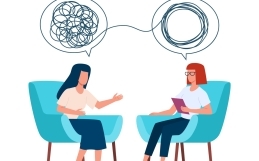“We all have an infant inside of us, but the infant doesn’t have to run the show.”
–Murray Bowen
“That idiot cut me off on purpose!” “My wife did that to spite me so I would have a bad day!” “My kid knows better and made a mess just to see me clean it up!” All of us have had thoughts like these. We make assumptions about others’ behavior, assuming the worst and seeing nothing but flaws. Without giving anyone the benefit of the doubt, we get revved up, assuming other people and external situations are to blame, when it’s actually our own thoughts, ideas, and anxiety making us reactive and angry.
Think about it. When we make mistakes, we treat them as just that; we don’t assume there are any evil intentions lurking beneath the surface. Since most of us don’t think of ourselves as bad people, we don’t consider ourselves to be intrinsically flawed when we make mistakes. While our assumptions make monsters out of others, we don’t make the same assumptions about ourselves. We quickly forgive ourselves for accidentally cutting someone off in traffic, getting our spouses upset, or making a mess with no bad intentions. Seeing ourselves and our actions clearly in this way is what looking at the facts is all about. When we get overly upset with other people for making mistakes, claiming they acted intentionally or had some evil plan to ruin our lives, we allow our anger, anxiety, and reactivity to keep us from seeing the facts.
Remaining factual about situations and people allows us to see things as they are—not the way our anger would have us see them. When we’re in distress, we tend to allow our anxiety, anger, and reactivity to run the show. Once we’re upset and reactive, we make assumptions, exaggerate the truth, and blame other people for our circumstances—all of which tends to get us even more anxious. So how do we exit the emotional arena and stay grounded in the facts when experiencing predicaments? What can we do when we’re caught up in our assumptions, seeking to dump our irritations onto others?
We live in a society that encourages us to release unpleasant emotions as soon as we feel them, instead of attempting to regulate ourselves by thoughtfully considering the reality of our circumstances. If only we could learn to calm ourselves down instead of looking for others to give us relief. If only we could watch our anxiety without placing it on someone else. If only we could learn to distinguish between emotional reactivity and thinking. But, you see, we can do this. And here’s how. Whenever a situation arises, we can ask ourselves this important question: “How much of my reaction is coming from anxiety, and how much is grounded in the facts?” This is how we begin to develop awareness of how our reactions contribute to the situation at hand and amplify our anxiety and distress.
Here are some strategies for remaining emotionally neutral. Practicing them will allow you to reduce your anxiety, reactivity, and anger during difficult times.
- Maintain Awareness. All change begins with awareness. Remaining aware of what’s happening will allow you to remain in contact with the problem, without fully being part of it. For example, if your spouse does something that upsets you, start to become aware of your natural reactions to him/her. Invite this self-awareness without judgment. See what assumptions come up, and realize that they’re just that: assumptions. Ask yourself how much of what you’re assuming is rooted in the facts, and how much is stemming from your own anxiety.
- Manage Your Emotions. Managing your emotions is instrumental in the process of developing a solid sense of self, allowing you to gain objectivity about your emotional process. This allows for emotional maturity, which significantly reduces anxiety, anger, and reactivity. It helps you develop a way to manage your anxiety in moments of stress, effectively taking control of yourself and your actions.
- Build Maturity. When you start to build maturity, you quickly notice the difference between looking for an immediate solution to relieve your anxiety and making a decision that will serve you well in the future. Think about the goals you have for your relationships, and consider the best way to respond instead of reacting impulsively in the moment to release your tension.
- Act for Self. When you act for self, you don’t avoid or shift blame. You don’t try to fix things, and you don’t take anything personally. You avoid attacking others. Instead, you focus on yourself and your boundaries, noticing and understanding how your reactivity evolves. Instead of reacting to change yourself, you thoughtfully reflect on how you want to respond to the situation at hand.
- Avoid Blaming and Pointing the Finger. Many people react to situations based on their emotions, not looking at the facts or taking ownership of their actions and reactions. This usually isn’t the best way to deal with things; nothing can be effectively resolved when emotions are running high. When we avoid blaming and finger-pointing, we’re able to create more fulfilling relationships, because reducing our own anxiety, anger, and reactivity makes us more available to communicate effectively and openly.
When we don’t remain objective or factual, we tend to make problems worse. Even if a situation appears to call for high levels of emotion, we don’t act like our best selves when we’re reactive or angry. When we can look at the facts, concentrating on the reality of a situation and not our feelings about it, we reduce our anxiety. It turns out that the facts of most situations aren’t as scary as our emotions would lead us to believe they are, so staying grounded in the facts allows us to self-regulate effectively under even the most difficult circumstances. Hard times will occur in life no matter what, and we’re much better off when we can manage ourselves through them.
Did you enjoy reading this article?
Once a week I send out a newsletter with new articles and unique content for readers. It is my way of staying in touch with you and giving you free advice based on some important topics. Click here to sign up for my newsletter.





